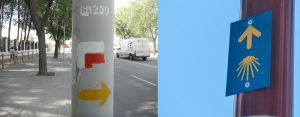 The signposting in Albacete is in plates with arrows and shells.
The signposting in Albacete is in plates with arrows and shells.
You enter Albacete by crossing the motorway over the flyover and the railway line, also over a bridge. You walk between small houses, along the so-called “Camino de las Casitas Coloradas”, parallel to the AVE railway line for about 300 metres. You pass under a bridge over the railway and on your right you find a sharp bend with a walkway, enter it, go over the railway, at the end turn right, along the long street of San Pedro, you reach the Plaza-Rotonda del Sol, turn slightly to the right to look for the pedestrian crossing and go to the left, go round this square and turn right into Calle Puerta de Chinchilla, then Calle Herreros, Plaza de la Cruz, where you will find what is left of the Cruz de término, Calle Cruz and San Agustín and you will reach the Plaza del Altozano, and Calle Martínez Villena will take you to the Cathedral.
- Town Hall: Plaza de la Catedral, 3. Tel: 967 596 100
- Hostal Atienzar: Carmen, 49. Tel: 967 210 595
- Hotel Castilla: Paseo de la Cuba, 3 Tel: 967 214 288
- Hotel Altozano: Plaza Altozano, 7. Tel: 967210462
It was a hospitable city: it had a hostel, founded by Brother Antonio de San José of the Congregation of the Hospitality of the Divine Shepherd, and a convent of the Antonianos Fathers or of San Antonio Abad, which also served as a hostel until the 19th century.
The cathedral is dedicated to San Juan Bautista, located next to the Hospital street, from the 16th century, built on top of the previous Gothic temple.
The Posada del Rosario dates from the 16th century and is located on the street del Rosario, on the corner with the street del Tinte. It is a mixture of styles: Gothic, Mudejar and Renaissance. The building has a Tourist Office and a University Library.
The Passage Lodares, built in 1925, is a gallery of commercial premises imitating the Italian Corsicans of Milan. It is worth a visit.
At the moment, there is no hostel.